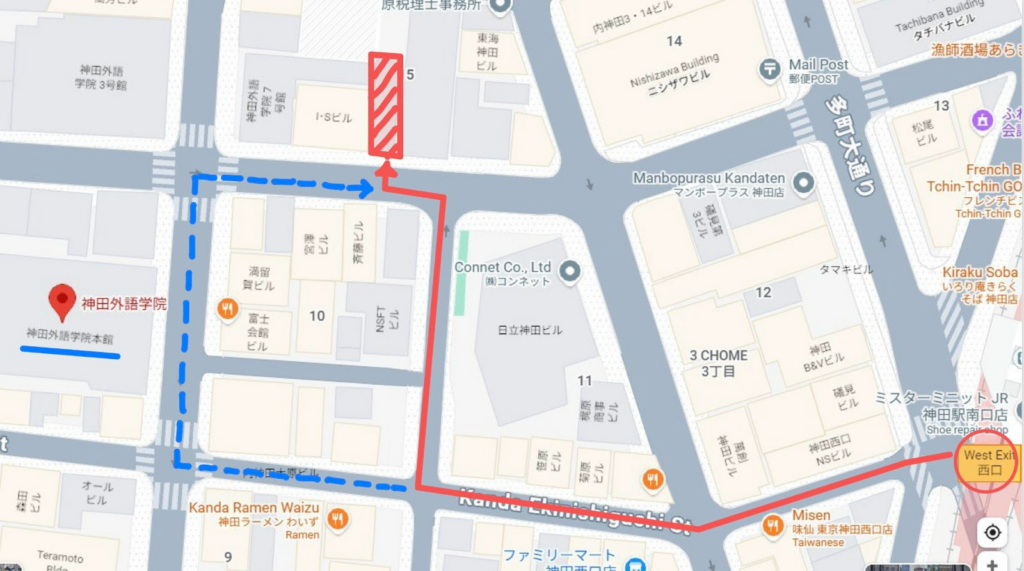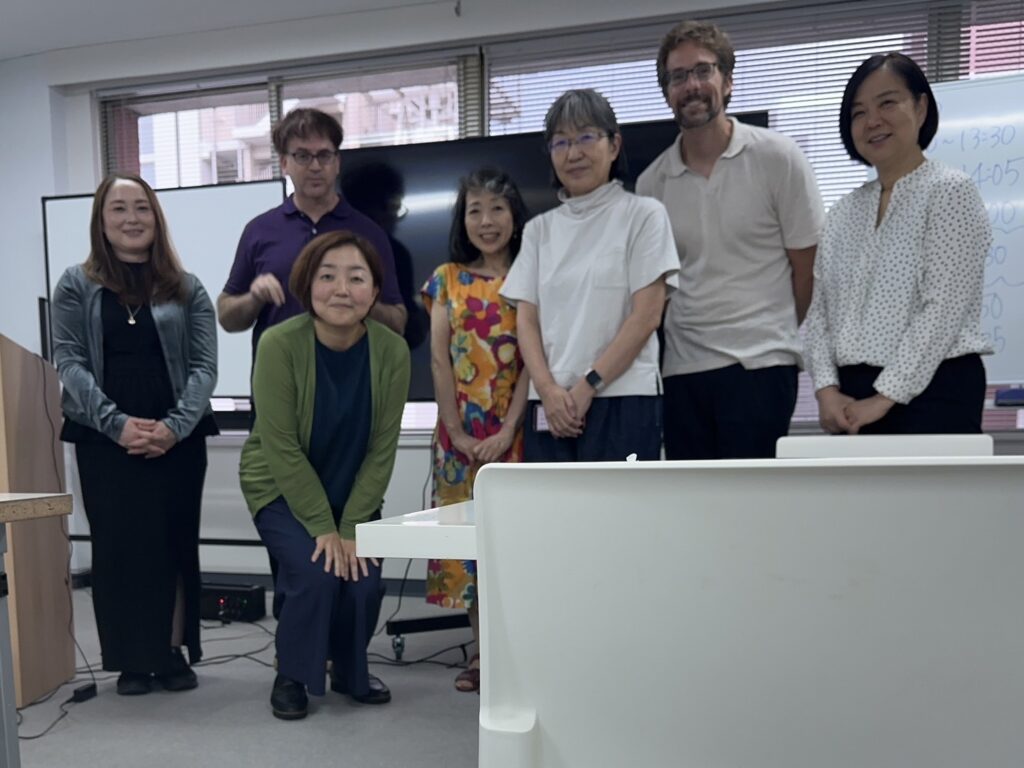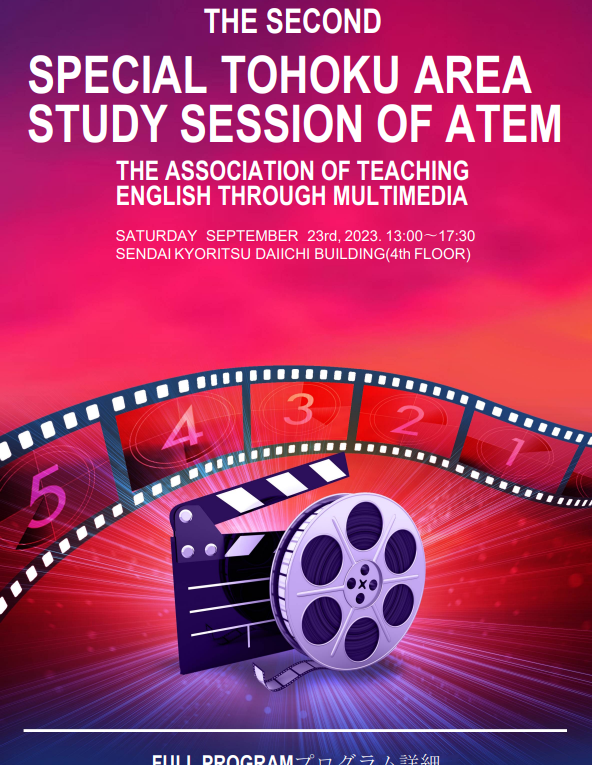2025年度 第16回 ATEM(映像メディア英語教育学会)冬季支部大会プログラム
〔例会日時〕 2025年12月20日(土)
〔会場〕神田外語学院 10号館 4階 401教室
東京都千代田区内神田2丁目13-13(本館住所)
(千葉県の幕張にあります「神田外語大学」とお間違いのようご注意ください)
JR神田駅(中央線・山手線・京浜東北線)から徒歩2分
東京メトロ銀座線神田駅から徒歩3分
※駅から10号館までの地図はこちらのプログラムの最後のページをご参照ください。
〔開催形態〕 対面開催(発表は会場で行います。オンライン発表はありません)
・遠隔参加する聴講者向けに、リアルタイム中継(配信)を行います。
・対面開催で実施するため、発表者は会場にお越しください。聴講につきましては、会の盛況のためにもなるべく会場にお越しいただけましたら幸いです。
オンラインで参加される方は、以下のGoogle formsにてご登録ください [12月18日(金)23:59まで]。後日ZoomのURLをお知らせします。
→学会参加・事前登録URL: https://forms.gle/r6B22RXBwtFt7n9S6
〔懇親会〕支部大会の後に懇親会を予定しております。(事前予約制)
参加ご希望の方は、こちらの懇親会参加フォーム(Google forms)にて申し込みください[12月15日(金)23:59まで]。
→懇親会参加・事前登録URL: https://forms.gle/HxGjRWEqLbFJfCkE9
————————————————————————————————–
▼スケジュール
9:30–10:00 受付 & 発表者リハーサル(希望者)
10:00–10:05 開会挨拶
10:05–10:35 発表1(発表20分 + QA5分 + 入れ替え/次の発表準備5分)
「映画『ワンダー 君は太陽』に見ることばの力英語授業を通じた人間力育成の試み―」
渡邊 信(麗澤大学)
10:35–11:05 発表2(発表20分+ QA5分 + 入れ替え/次の発表準備5分)
「外国人が感じる日本の音」
関口 美緒(メリーランド大学、東京科学大学)
11:05–11:35 発表3(発表20分 + QA5分 + 入れ替え/次の発表準備5分)
“Filmmaking and Adaptation as Iterative Practice”
Alec McAulay(Yokohama National University)
11:35–12:05 昼休憩
12:05–12:30 総会
12:30–13:00 発表4(発表20分 + QA5分 + 入れ替え/次の発表準備5分)
“Google Scripts for Creating Video-Integrated Speaking Tasks”
Ryan SPRING(Tohoku University)
13:00–13:30 発表5(発表20分 + QA5分 + 入れ替え/次の発表準備5分)
「YouTube動画教材の開発と有効性検証:教材デザイン理論に基づくアプローチ」
中村 佐知子(東北大学)
13:30–14:00 発表6(発表20分 + QA5分 + 入れ替え/次の発表準備5分)
“Reimagining Film-based ELA Pedagogy with Generative AI: Exploring Use Cases for Night at the Museum”
Makito Kawata(Kanda University of International Studies)
14:00–14:30 発表7(発表20分 + QA5分 + 入れ替え/次の発表準備5分)
「ソフィア・コッポラ監督 Marie Antoinette (2006) に見える『メディア文化』」
塚田 三千代(翻訳、日本ペンクラブ電子文藝館委員)
14:30–14:45 休憩 / Break(15分)
14:45–15:15 発表8(発表20分 + QA5分 + 入れ替え/次の発表準備5分)
「英語教材としてのカットシーン―句動詞とその関連表現を題材に―」
三村 仁彦(帝塚山大学)
15:15–15:45 発表9(発表20分 + QA5分 + 入れ替え/次の発表準備5分)
「映画にみる日米の文化的無意識 ― 異文化理解教育への応用 ―」
斎藤 珠代(東北学院大学)
15:45–16:15 発表10(発表20分 + QA5分 + 入れ替え/次の発表準備5分)
「アメリカ文化と西部劇の伝統ー映画『ノー・カントリー』(No Country for Old Men, 2007)の場合」
日影 尚之(麗澤大学)
16:15–16:45 発表11(発表20分 + QA5分 + 入れ替え/次の発表準備5分)
「子どもの発話コーパスCHILDES の音声・映像データを使った up/down 研究への試み」
濱上 桂菜(滋賀県立大学)
16:45–16:50 閉会の挨拶
16:50–17:20 役員会
17:30–18:00頃 懇親会
■ 発表に際しての留意点
1. スライド構成について
動画や音量、スクリーン反映などの機材トラブルにより、意図した形で発表ができなくなる事例が見られます。役員が可能な限りサポートいたしますが、人員に限りがあるため、発表スライドはなるべくシンプルで、補助機器を必要としない構成をご検討いただけますと幸いです。この点に関連し、以下2.、3.もご参照ください。
2. 動画再生に関するお願い
特にトラブルが起こりやすい例として、PPTスライド → 別ウィンドウ → 動画 → YouTube へと切り替える操作を同一発表内で行う場合が挙げられます。
可能な範囲で動画をご自身の機器に取り込み、PPT内に貼り付けるなど、切り替えを必要としない方法をご検討ください。万が一に備え、画像で代替説明できる準備があると安心です。
3. 音量設定について
ご自宅での準備段階の音量と会場機器につないだ際の音量に差が生じるケースが見られます。ご自身のPC・USB内の動画/音声資料は、あらかじめ十分大きめの音量で収録・設定していただけますと助かります。
4. 発表中の音・私語について
発表中にスマホアプリの通知音が鳴ると、発表者・聴衆ともに集中が阻害される可能性があります。通知オフ設定のご協力をお願いいたします。また、発表中の私語につきましてもご配慮いただけますと幸いです。
神田駅西口から10号館までの地図
(赤線が近道ですが、間違えて本館まで行っても青線を辿っていただくと10号館に着きます)

ストリートビューによる10号館概観(真ん中の細い建物です)
▼プログラム(発表概要)
9:30–10:00 受付 & 発表者リハーサル(希望者)
10:00–10:05 開会挨拶
10:05–10:35 発表1(発表20分 + QA5分 + 入れ替え/次の発表準備5分)
「映画『ワンダー 君は太陽』に見ることばの力英語授業を通じた人間力育成の試み―」
渡邊 信(麗澤大学)
概要:本発表では、麗澤大学の英語教職科目「人間力育成演習」(本学独自の科目)における授業実践として、映画『ワンダー 君は太陽』(2017年)を用いた授業を報告する。本授業では、登場人物オギーやブラウン先生の台詞を通して、差別、いじめ、友情、思いやりといったテーマを学生とともに考察した。特に、ブラウン先生の格言“When given the choice between being right or being kind, choose kind.”(正しいことより親切を選べ)を中心に、学生が自らの価値観を英語で表現する活動を行った。その過程で、英語学習を通じて他者理解を深め、自分の生き方を省みる姿が見られた。本実践は、映像メディアを活用した英語教育が、言語力だけでなく人間力を育む教育としても有効であることを示唆している。
10:35–11:05 発表2(発表20分+ QA5分 + 入れ替え/次の発表準備5分)
「外国人が感じる日本の音」
関口 美緒(メリーランド大学、東京科学大学)
概要:日本人は「虫の声」を聴くというが、外国人には「虫の音」や「雑音」にしか聞こえないという。そこで、本研究では、外国人日本語学習者に日本の様々な自然音を聞かせて調査した。調査は、2023年秋学期に名古屋大学G30プログラムアカデミック日本語2B(Listening and Presentation)のクラスでのListeningの一環として行った。様々な音があるが、主に自然音と動物の鳴き声(虫の音)を対象にした。その結果、日本人には心地よく聞こえる音や、音として認識するより「声」としての情緒を認識している音が、外国人学習者は「不快」であったり、「恐怖」を感じたりという結果が出た。また、2025年1月にオンラインでメキシコのセラヤ工科大学の5名にも聞き取り調査を行った。それらの結果を踏まえて、外国人日本語学習者が自然音を心理的にどう感じ、どんな傾向がみられるかを分析し、仮説を立て、考察した結果を報告する。(2023年度全国大会改訂版)
11:05–11:35 発表3(発表20分 + QA5分 + 入れ替え/次の発表準備5分)
“Filmmaking and Adaptation as Iterative Practice”
Alec McAulay(Yokohama National University)
Abstract: This presentation outlines a pedagogical approach to teaching filmmaking and adaptation studies through iterative practice, an active, cyclical method in which students repeatedly reinterpret and reframe source materials, including films produced by other students. Moving away from adaptation as a static comparison between “original” and “derivative” texts, this method helps students understand that adaptation in filmmaking is a process of creative negotiation, critical discovery, and playful dialogic reinterpretation. Drawing on a recent example from my Seminar on Filmmaking, I will show a short film made by one group of students, the graduates of 2024, that was inspired by a source text (a short film) available online. I will then ask participants to mirror the process the students in the graduating class of 2025 went through, namely analyzing the film made by their seniors to identify what could be improved in a re-make. We will then watch the re-make by the 2025 students and identify what changes they made, and discuss how they came to make the creative decisions that we see on screen. I hope to demonstrate how iterative exercises foster deeper understanding of adaptation’s creative potential. In addition, I will show how this pedagogical approach allows students to use English authentically to develop analytical and creative skills in both academic and production-oriented environments.
11:35–12:05 昼休憩
12:05–12:30 総会
12:30–13:00 発表4(発表20分 + QA5分 + 入れ替え/次の発表準備5分)
“Google Scripts for Creating Video-Integrated Speaking Tasks”
Ryan SPRING(Tohoku University)
Abstract: In recent years, automatic speech recognition (ASR) has become increasingly easy to use and can now be implemented for free to create extracurricular speaking practice for EFL students (e.g., Hamagami et al., 2025; Nakamura et al., 2024; Spring et al., 2025). However, the price-to-entry for creating customized ASR tasks can still be quite high, as creating them requires quite a bit of technological knowledge, an individual website, and the proper security certifications. Here, Google Scripts can be be a potential solution as it allows anyone to make a deployable app that writes the data in a Google Sheet, which can be used as a database. This removes the necessity for one to have their own website or security certifications. In order to reduce the amount of technical knowledge required, I created several scripts and videos explaining how to use them and modify them to match teachers’ classes. This presentation shows the types of scripts that are available, how to modify them, and invites the audience to follow along and create their own original ASR speaking task.
13:00–13:30 発表5(発表20分 + QA5分 + 入れ替え/次の発表準備5分)
「YouTube動画教材の開発と有効性検証:教材デザイン理論に基づくアプローチ」
中村 佐知子(東北大学)
概要:教材開発においては、学習者の経験を重視し、評価と改善を通じて教材の質を高めることが重要である(Tomlinson, 2012)。本発表では、このTomlinsonの理論的視点を背景とし、教材開発における一般的なプロセスであるニーズ分析、設計、実践、評価、改善という段階的サイクルを意識的に適用することで、YouTubeを活用した動画教材「Scaffolded Retention Practice(SRP)」の開発と実践的検証を行った経緯を報告する。SRPは、学習者への支援を段階的に減らしながら、学習者のフレーズ習得と総合的な英語スキル向上を促す目的で独自にデザインされた。発表者はその効果を授業実践を通じて検証し、得られた学習データを分析し、さらに教材改善につなげてきた。また、教材作成に利用可能なツールの進化は目覚ましく、教員が新しい技術や手法を柔軟に取り入れ、この開発サイクルに組み込むことが、結果としてより効率的で質の高い教材提供につながることを論じる。
13:30–14:00 発表6(発表20分 + QA5分 + 入れ替え/次の発表準備5分)
“Reimagining Film-based ELA Pedagogy with Generative AI: Exploring Use Cases for Night at the Museum”
Makito Kawata(Kanda University of International Studies)
Abstract: Research on teaching English as a foreign language has long highlighted the pedagogical value of using films, noting their multimodal input, rich cultural content, narrative engagement, and capacity to motivate learners across proficiency levels. At the same time, the use of films in educational settings presents both benefits and challenges. For example, the positive motivational effects of film-based instruction have been reported (Kondo, 2018), whereas material development for film-based lessons is time-intensive and often needs to be created from scratch (Kadoyama, 2016). Furthermore, studies on film-use in EFL contexts tend to focus on short scenes rather than full-length movies, despite recent work supporting the educational value of experiencing an entire film narrative (Endo, 2024). This presentation examines how generative AI offers a bridge between these challenges and the pedagogical strengths of films. Drawing on a full-term university English course built around Night at the Museum (2006), it will demonstrate how AI tools can extend core principles of movie-based pedagogy. Examples include AI-generated tasks that support vocabulary acquisition (e.g., word and expression lists, definitions, synonyms, collocations, example sentences), language skill development (e.g., scene-inspired dialogues for speaking and listening activities, theme-based materials for reading and writing tasks), and intercultural inquiry through noticing and research assignments. Creative methods will also be explored, such as simulated character interactions that allow learners to “interview” characters on their experiences, motives, and values—even those beyond what appears in the film. Generative AI can function as a catalyst that reduces the barriers to designing level-appropriate classroom materials while preserving the uniquely powerful contributions of films, including engaging narratives and rich linguistic and cultural representations. Participants will gain a practical framework for adopting AI-assisted workflows to support film-based lessons and courses in EFL contexts.
14:00–14:30 発表7(発表20分 + QA5分 + 入れ替え/次の発表準備5分)
「ソフィア・コッポラ監督 Marie Antoinette (2006) に見える『メディア文化』」
塚田 三千代(翻訳、日本ペンクラブ電子文藝館委員)
概要:ソフィア・コッポラ監督の映画作品Marie Antoinette(2006年)はヴェルサイユ宮殿で過ごしたマリー・アントワネットの旅路を描いている。フランスとオーストリアの同盟国を成立させるための鍵となったマリー・アントワネットは異文化融合して自己アイデンティティを変容させる。その変容過程やセリフ(movie lines)に注目した。当時のフランス・ブルボン宮廷文化はあらゆる情報手段/メディアを使用して国内外で優越していた。本研究では、フランス・ブルボン宮廷の中央集権・絶対王政下におけるメディアの事例データ(data on examples)を収集して分布グラフに表示し、複数のメディアが情報循環/相互作用してメディアの多様化と応用範囲を広げる社会動態を可視化した。本日の発表ではメディア文化の定義、ブルボン宮廷のメディア事例、異文化融合とアイデンティティ変容、英語教育への適用について討議する。
14:30–14:45 休憩 / Break(15分)
14:45–15:15 発表8(発表20分 + QA5分 + 入れ替え/次の発表準備5分)
「英語教材としてのカットシーン―句動詞とその関連表現を題材に―」
三村 仁彦(帝塚山大学)
概要:近年,家庭用ゲーム機の進化に伴い,ゲーム自体の内容も大作志向のものが多くみられるようになった。そのような作品においては,ストーリーの要所でカットシーン(cutscene)と呼ばれる映像が流れることがほとんどだが,そのクオリティはあらゆる面でアニメ映画や実写映画と比べてもまったく遜色がない。本発表では,これらのカットシーンが英語教材として十分な資質を備えていることを明らかにし,新たなメディア教材のひとつとして非常に有望であることを主張する。具体的には,人気ゲーム『メタルギアシリーズ』の最新作,『メタルギアソリッド デルタ:スネークイーター』(METAL GEAR SOLID Δ: SNAKE EATER)のカットシーンから,基本動詞を含む句動詞(phrasal verb)とその関連表現をいくつか取りあげ,同トピックを扱った複数の大学英語教材の内容と照らし合わせることで,当該シリーズのカットシーンがこれらの表現の学習に有用であることを示す。
15:15–15:45 発表9(発表20分 + QA5分 + 入れ替え/次の発表準備5分)
「映画にみる日米の文化的無意識 ― 異文化理解教育への応用 ―」
斎藤 珠代(東北学院大学)
概要:Sakamoto&Naotsuka(1989)は日米の文化を比較し、コミュニケーションにおいて誤解が生じる場合に、日米それぞれの言語活動の背後に無意識レベルでの「前提」があると考え、それらをPolite fictionsと呼んでいる。つまり、日本人もアメリカ人も互いに礼儀正しくあろうとして一種の虚構を演じている、というのである。Sakamoto&Naotsukaはいくつかのそういった心理的前提を提示して論じているが、その中から、本報告では2つの前提を取り上げ、映画の中で具体的にどのように表現されているか見ていきたい。一つはConversational ballgamesで、もう一つはYou and I are independentである。前者の例として、ディズニー映画『ライオンキング』から2つの場面が挙げられる。悪役の一味であるハイエナの3匹が交わす会話と主人公シンバとその仲間たちの間で交わされる会話である。後者の例としてはディズニー映画『ムーラン』と『7月4日に生まれて』から取り上げる。本報告で、映画の場面を用いて文脈と共に確認することで、異文化理解を深める効果があることを示したい。
15:45–16:15 発表10(発表20分 + QA5分 + 入れ替え/次の発表準備5分)
「アメリカ文化と西部劇の伝統ー映画『ノー・カントリー』(No Country for Old Men, 2007)の場合」
日影 尚之(麗澤大学)
概要:映画『ノー・カントリー』(No Country for Old Men, 2007) では、テキサスや米墨国境付近を主な舞台に、麻薬取引の決裂跡から金を盗んだ Llewelyn Moss、それを執拗に追跡する Anton Chigurh、事件を解決したい保安官Tom Bell などが逃走と追跡、銃撃戦などを繰り広げる。しかし、映画冒頭の西部劇的なパノラマ風景にもかかわらず、西部劇的プロットや映像手法は裏切られる。Lee Clark Mitchell (2018) は「閉所恐怖症」(claustrophobia)こそは伝統的西部劇の構成要素という説明も引き合いに出しながら、この映画における西部劇とノワールのジャンル間衝突 (duel)について論じ、冒頭とエンディングの語り手でもあるBell 保安官の苦悩および西部劇的思考の呪縛の根強さについて指摘する。Bellが2つの夢について妻に語り、カチカチと時を刻む…エンディングについてはどう考えるのがよいのだろうか?
16:15–16:45 発表11(発表20分 + QA5分 + 入れ替え/次の発表準備5分)
「子どもの発話コーパスCHILDES の音声・映像データを使った up/down 研究への試み」
濱上 桂菜(滋賀県立大学)
概要:CHILDES は、子どもの会話やその周辺の人の発話を収集したコーパスであり、英語・日本語を含む多様な言語データを備え、主に言語習得研究に利用されている。本発表では、CHILDES オンライン版の英語データのうち、とくに音声・映像資料に着目し、up/down の多義的用法に関する探索的分析と、関連分野への応用可能性を検討する。子どもの発話には、音声が不明瞭であったり、発話の意図や内容が取りづらかったりといった特有の難しさがある。その一方で、CHILDES を用いることで月齢差・年齢差による使用傾向や、大人からの働きかけを明らかにすることが可能であり、研究上の多様な可能性を含んでいると考えられる。


